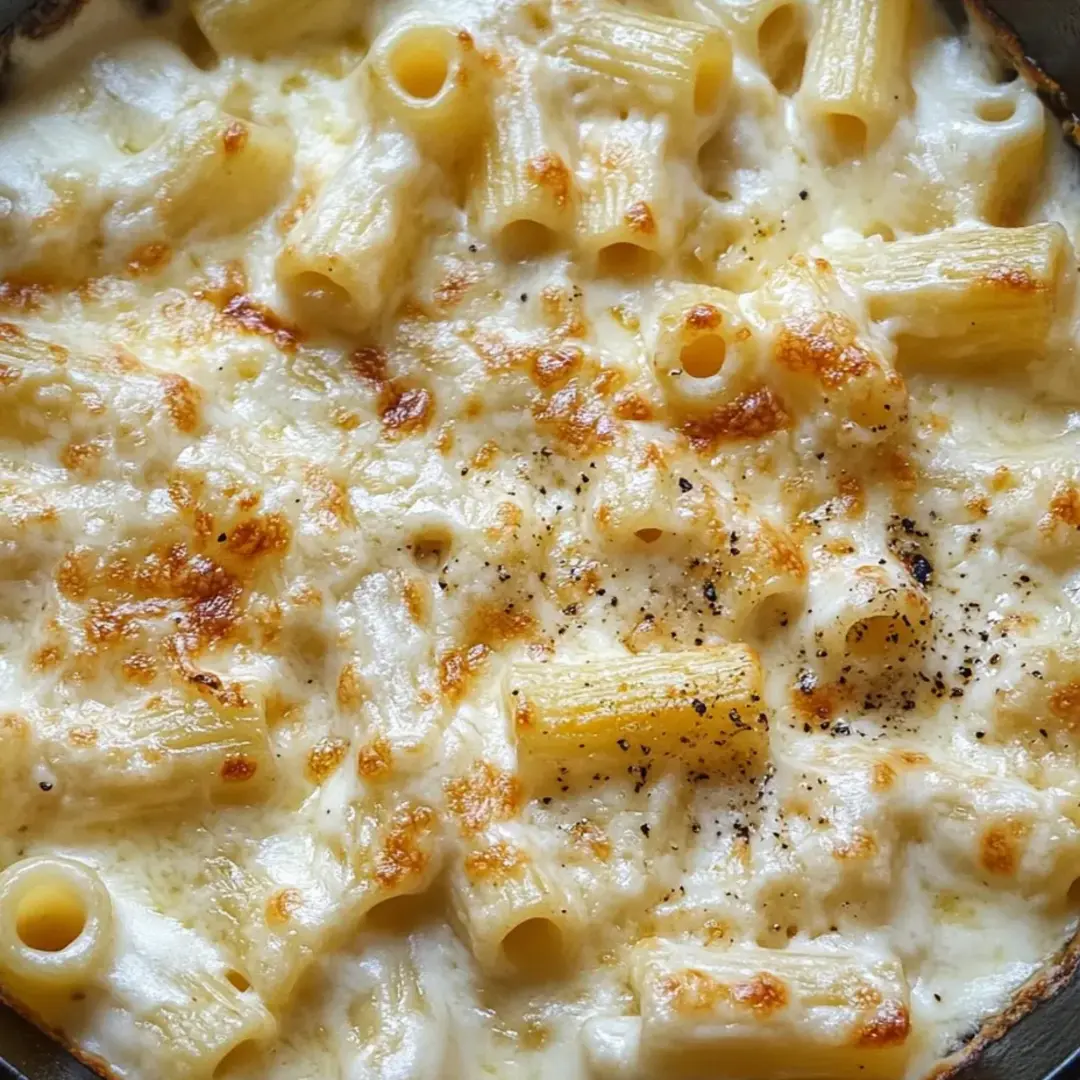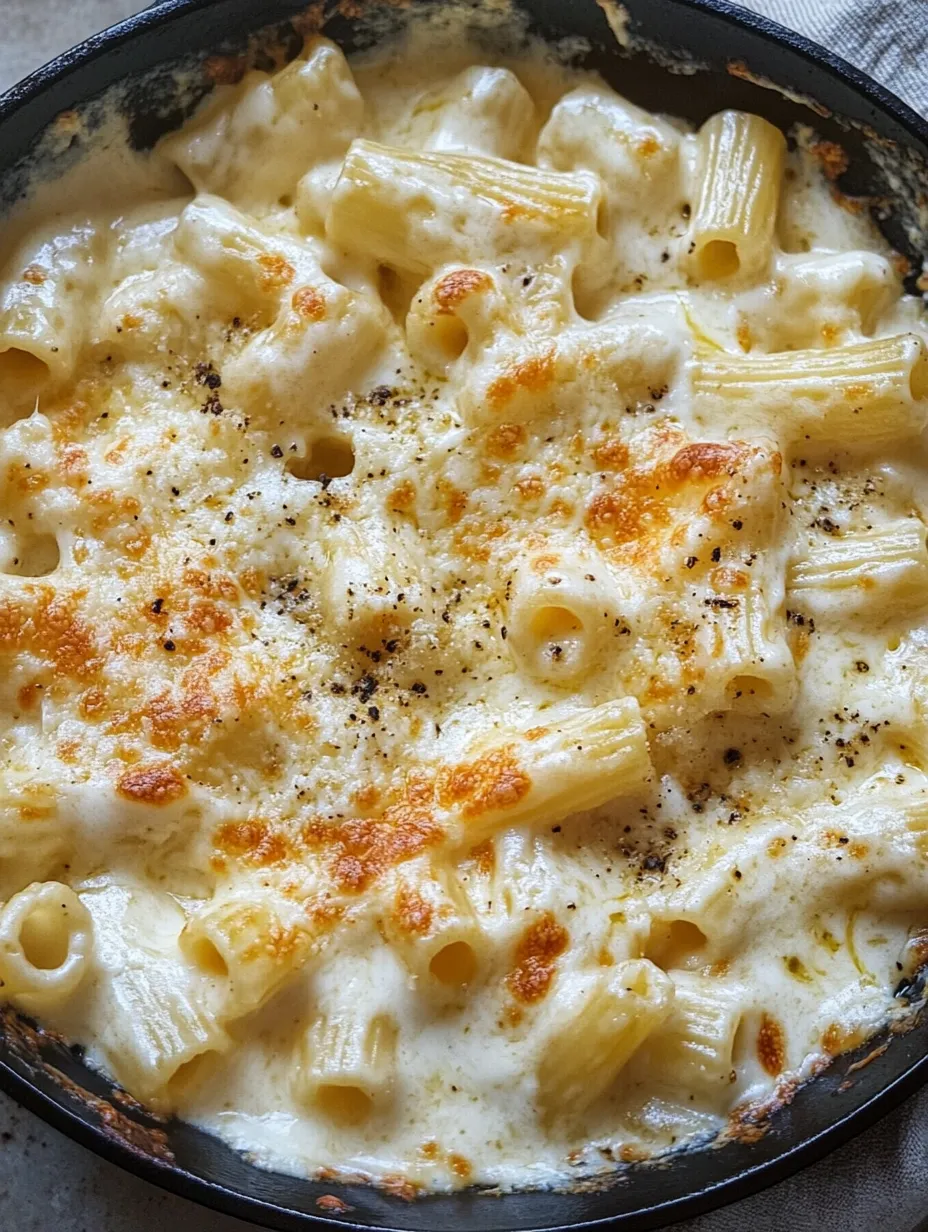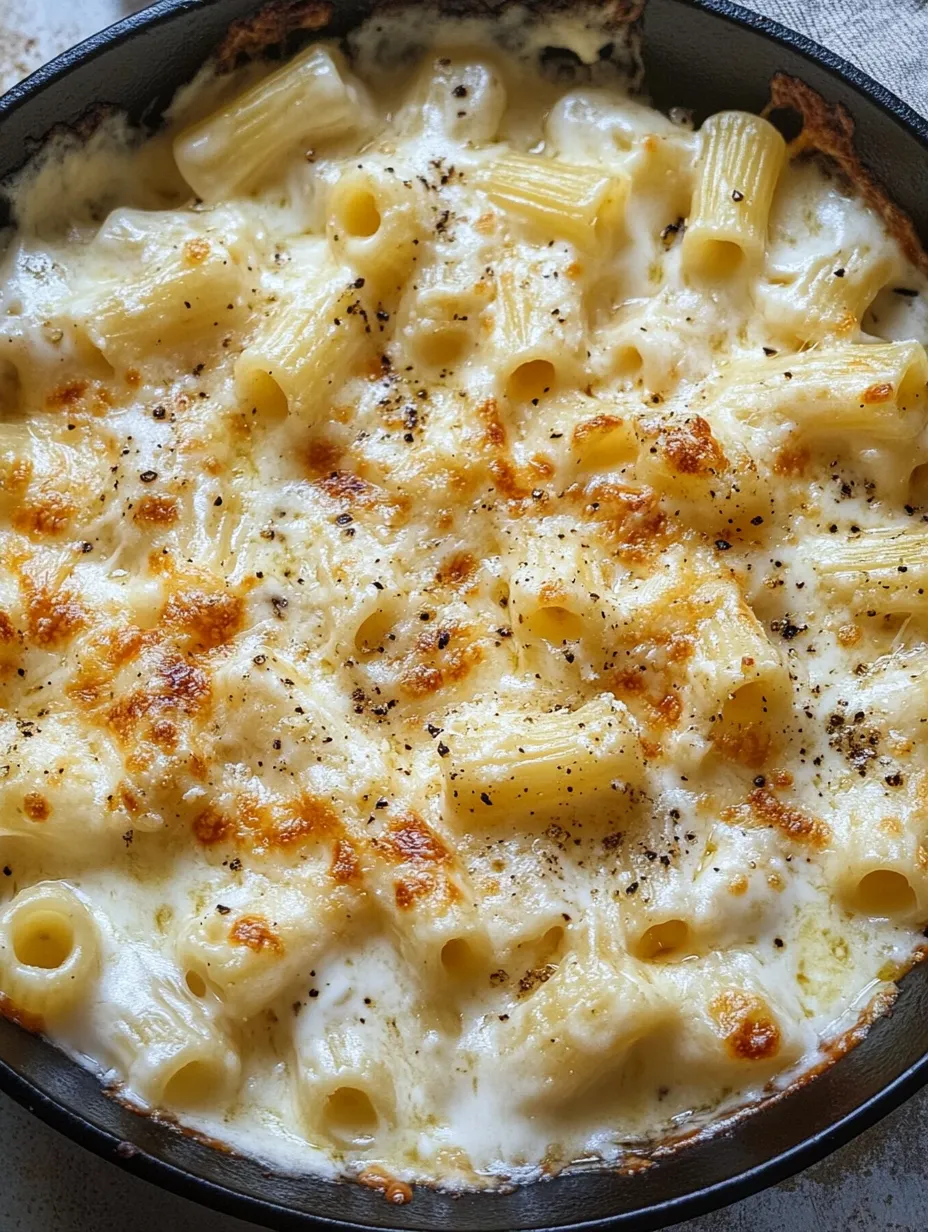 Pin it
Pin it
This Italian Mac and Cheese Bake transforms everyday pasta into something truly magical through the elegant simplicity of a classic bechamel sauce and quality cheeses. Unlike the bright orange American version, this centuries-old Italian approach creates a more sophisticated flavor profile with nutty Fontina and sharp Parmesan melting into a silky sauce that coats each piece of pasta. The beauty lies in its rustic preparation – approximate measurements, intuitive cooking, and a celebration of quality ingredients coming together to create something greater than the sum of its parts. When it emerges from the oven with its golden, bubbling surface, you'll understand why this humble dish has endured for 400 years.
I first discovered this recipe while scrolling through TikTok during one of those endless pandemic evenings. The Pasta Queen's authoritative voice declaring it a 400-year-old recipe immediately caught my attention. When I made it for my in-laws (who are notoriously picky about pasta), my father-in-law – who typically pushes pasta around his plate like a reluctant child – went back for seconds and then asked if there was more. My mother-in-law later texted requesting the recipe for her bridge club. That's when I knew this humble dish had something special that transcends trends and fads.
Ingredients for Italian Mac and Cheese Bake
- 1/2 pound rigatoni pasta: The substantial tubes catch and hold the creamy sauce beautifully. Their ridged exterior provides perfect sauce-gripping texture while the hollow center creates pockets of cheesy goodness.
- 4 tablespoons unsalted butter, divided: Creates the base for the bechamel and adds richness to the finished dish. Use high-quality European butter if available for its higher butterfat content and superior flavor.
- 4 tablespoons all-purpose flour: Works with the butter to form a roux that thickens the sauce. Weighing rather than measuring ensures perfect consistency every time.
- 2-3 cups whole milk, warmed: Transforms the roux into a silky bechamel sauce. The fat content in whole milk creates the most luxurious texture; never substitute lower-fat alternatives.
- 8 ounces Fontina cheese, cubed: Provides exceptional meltability and a nutty, slightly sweet flavor that's more complex than mozzarella. Look for authentic Fontina Val d'Aosta from Italy if you can find it.
- 1 cup freshly grated Parmesan cheese, divided: Contributes sharp, salty notes that balance the creaminess of the bechamel and Fontina. Always grate it fresh; pre-grated versions contain anti-caking agents that prevent proper melting.
- Salt and freshly ground black pepper, to taste: Enhances and balances all the other flavors. Diamond Crystal kosher salt and freshly cracked black pepper provide the cleanest taste.
- Pinch of nutmeg (optional): Traditional in bechamel, it adds subtle warmth without being identifiably spicy. Freshly grated nutmeg is significantly more aromatic than pre-ground.
I'm particularly passionate about the cheese selection in this recipe. After experimenting with various combinations, I've found that Fontina provides the ideal melting quality while contributing a distinct flavor that elevates this beyond ordinary mac and cheese. The small cubes create pockets of gooey cheese throughout the dish rather than disappearing completely into the sauce. Meanwhile, the Parmesan adds that essential umami quality that makes you keep coming back for one more bite.
 Pin it
Pin it
Step-by-Step Instructions
- Step 1: Prep Oven and Pasta Water
- Begin by preheating your oven to 400°F (200°C) with a rack positioned in the middle. The high temperature creates a beautifully golden crust while maintaining a creamy interior. Take an oven-safe skillet or saucepan out now – ideally one that's attractive enough to serve from, saving you a dish to wash later.
- Step 2: Cook Pasta
- Bring a large pot of water to a rolling boil. Add a generous handful of salt – the water should taste like the sea. This is your only opportunity to season the pasta itself, so don't be shy with the salt. Add the rigatoni and cook until just shy of al dente, about 2 minutes less than the package directions suggest. The pasta will continue cooking in the oven, so slightly undercooking it now prevents mushiness later.
- Step 3: Make Roux
- While the pasta cooks, begin making the bechamel sauce. In your oven-safe skillet or saucepan, melt 3 tablespoons of butter over medium heat until it foams but doesn't brown. The foaming indicates the water is evaporating, leaving pure butterfat behind – the perfect foundation for your sauce.
- Step 4: Add Flour
- Once the butter has melted completely, add the flour all at once and whisk immediately to incorporate. Cook this mixture (called a roux) for about 2 minutes, whisking constantly. This cooking step eliminates the raw flour taste while maintaining its thickening power. The roux should be pale golden and smell slightly nutty when it's ready.
- Step 5: Create Bechamel
- Begin adding the warmed milk gradually, about half a cup at a time, whisking continuously to prevent lumps from forming. Each addition should be fully incorporated before adding more. Warming the milk beforehand prevents the sauce from seizing when liquid hits the hot roux. The gradual addition creates a silky-smooth sauce without any flour lumps.
- Step 6: Thicken Sauce
- Once all the milk has been added, continue cooking the bechamel, stirring frequently, until it thickens enough to coat the back of a spoon – about 5-7 minutes. When you run your finger through the sauce on the spoon, it should leave a clear path that doesn't immediately fill in. Season with salt, pepper, and a pinch of nutmeg if using.
- Step 7: Combine Pasta and Cheese
- Drain the pasta thoroughly but don't rinse it – the starch on the surface helps the sauce adhere better. Return the drained pasta to the empty pot temporarily or add it directly to the bechamel sauce if your pan is large enough. The hot pasta will help melt the cheese in the next step.
- Step 8: Add Cheeses
- Add most of the cubed Fontina and half of the grated Parmesan to the bechamel sauce (or to the pot with the pasta). Stir gently but thoroughly to combine, allowing the heat from both the sauce and pasta to begin melting the cheese. The Fontina won't completely melt at this stage – that's intentional, as it creates pockets of cheese throughout the finished dish.
- Step 9: Transfer to Baking Dish
- If you've been working in a separate pot, transfer the pasta and cheese sauce mixture to your oven-safe baking dish now. Spread it into an even layer, ensuring sauce reaches all the way to the edges. This prevents the exposed pasta from drying out during baking.
- Step 10: Add Toppings
- Sprinkle the remaining Parmesan evenly over the top of the pasta mixture. Cut the remaining tablespoon of butter into small cubes and distribute them across the surface. These butter pieces will melt during baking, creating rich golden spots on the finished dish.
- Step 11: Bake
- Place the dish in the preheated oven and bake until the top is bubbling and golden brown, approximately 10-15 minutes. The edges should be slightly crispy while the interior remains creamy. If additional browning is desired, you can briefly place it under the broiler for 1-2 minutes, watching carefully to prevent burning.
- Step 12: Rest and Serve
- Remove from the oven and let the dish rest for 5 minutes before serving. This brief rest allows the sauce to set slightly, making for neater portions. Serve directly from the baking dish for a rustic presentation that showcases the golden, bubbling surface.
The Art of Bechamel
The heart of this dish is the bechamel sauce – one of the five mother sauces in classical French cuisine that has been adopted by Italian cooks for centuries. While it sounds fancy, bechamel is simply a white sauce made from butter, flour, and milk. The key is understanding the proper proportion: equal parts butter and flour by weight (or volume, in a pinch), with enough milk added to reach your desired consistency.
Watch for visual cues rather than strict timing: the roux should bubble and foam when the milk first hits it, then gradually calm down as you whisk. The finished bechamel should have the consistency of heavy cream – thick enough to coat the back of a spoon but still pourable. If it becomes too thick, simply add a splash more warm milk and whisk until incorporated.
The true magic of bechamel lies in its versatility. Once you've mastered this basic white sauce, you've unlocked countless possibilities beyond mac and cheese – from classic lasagna to creamed spinach to savory soufflés. It's a foundational technique that connects home cooks across centuries and continents.
 Pin it
Pin it
Creative Variations to Try
While the classic version with Fontina and Parmesan creates an exceptional dish, the beauty of this recipe lies in its adaptability. Consider these variations to make it your own:
- Mediterranean Mac: Add sun-dried tomatoes, chopped artichoke hearts, and replace some of the Fontina with feta cheese for a Mediterranean twist. A sprinkle of dried oregano in the bechamel enhances the theme.
- Truffle Luxe: Incorporate a small amount of truffle oil or minced black truffle into the bechamel before adding the pasta. Pair with wild mushrooms sautéed separately and folded in before baking for an earthy, luxurious version.
- Spicy Calabrian: Add Calabrian chili paste to the bechamel and include some spicy Italian sausage (browned separately and drained) along with smoked scamorza cheese for a fiery southern Italian interpretation.
- Herbed Garden: Fold fresh chopped herbs like basil, parsley, and chives into the pasta mixture just before baking, and top with buttery toasted breadcrumbs mixed with lemon zest for brightness and texture.
These variations maintain the spirit of the original while allowing you to adapt the dish to your pantry contents or seasonal ingredients. The technique remains the same – only the accents change.
Serving and Storage Suggestions
This mac and cheese is at its absolute best served immediately from the oven, when the contrast between the crispy top and creamy interior is most pronounced. Serve it alongside a simple green salad dressed with lemon and olive oil to balance the richness of the pasta.
If you need to make it in advance, prepare everything up to the point of baking, cover tightly, and refrigerate for up to 24 hours. When ready to serve, allow the dish to sit at room temperature for 30 minutes before baking, and add 5-10 minutes to the baking time since you're starting with a cold dish.
Leftovers, should you be lucky enough to have any, will keep in the refrigerator for 3-4 days. Reheat individual portions in the microwave with a splash of milk to revive the creaminess, or larger portions in a 350°F oven until heated through.
I learned the importance of undercooking the pasta the hard way. The first time I made this dish, I cooked the rigatoni to perfect al dente before baking, and it ended up mushy in the final dish. Now I drain the pasta when it still has a noticeable firmness in the center – what Italian cooks would call "molto al dente" – and the texture in the final baked dish is spot-on every time. This simple adjustment makes a remarkable difference in the quality of the finished product.
What I appreciate most about this recipe is how it celebrates simplicity. In a culinary world often obsessed with novelty and trendiness, there's something deeply satisfying about preparing a dish that has sustained people for centuries. Each time I make it, I feel connected to generations of home cooks who found comfort and joy in transforming basic ingredients into something special. It's a reminder that sometimes the oldest recipes endure for good reason – they simply work, bringing people together around tables to share not just food, but conversation, laughter, and connection.
Frequently Asked Questions
- → Can I use different cheeses in this recipe?
- Absolutely! While sharp cheddar and Gruyère provide excellent flavor and meltability, you can substitute with fontina, gouda, or monterey jack. Just make sure to include at least one cheese that melts well.
- → Can I make this mac and cheese ahead of time?
- Yes, you can assemble everything up to the baking step, cover and refrigerate for up to 24 hours. When ready to serve, add 5-10 minutes to the baking time since it will be cold from the refrigerator.
- → How can I make this recipe gluten-free?
- Use your favorite gluten-free pasta, substitute the all-purpose flour with a gluten-free flour blend for the roux, and use gluten-free breadcrumbs for topping.
- → Why is my cheese sauce grainy?
- This usually happens when the sauce is heated too quickly or at too high a temperature. Always add cheese off the heat and stir until just melted. Pre-shredded cheese can also cause graininess due to anti-caking agents, so shredding your own is best.
- → Can I freeze this mac and cheese?
- Yes, you can freeze it either before or after baking. Thaw overnight in the refrigerator before baking or reheating. The texture may change slightly, but it will still be delicious.
